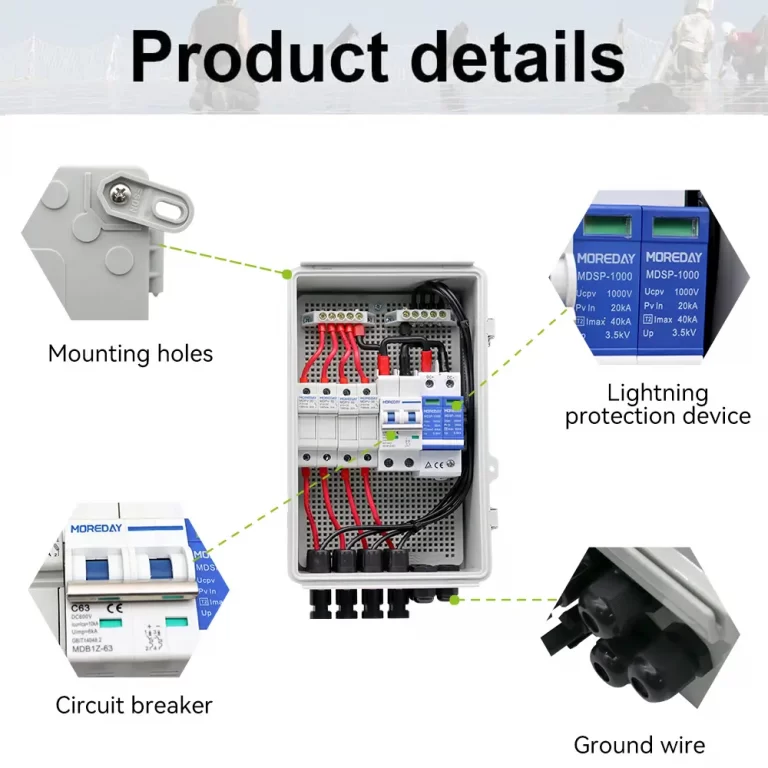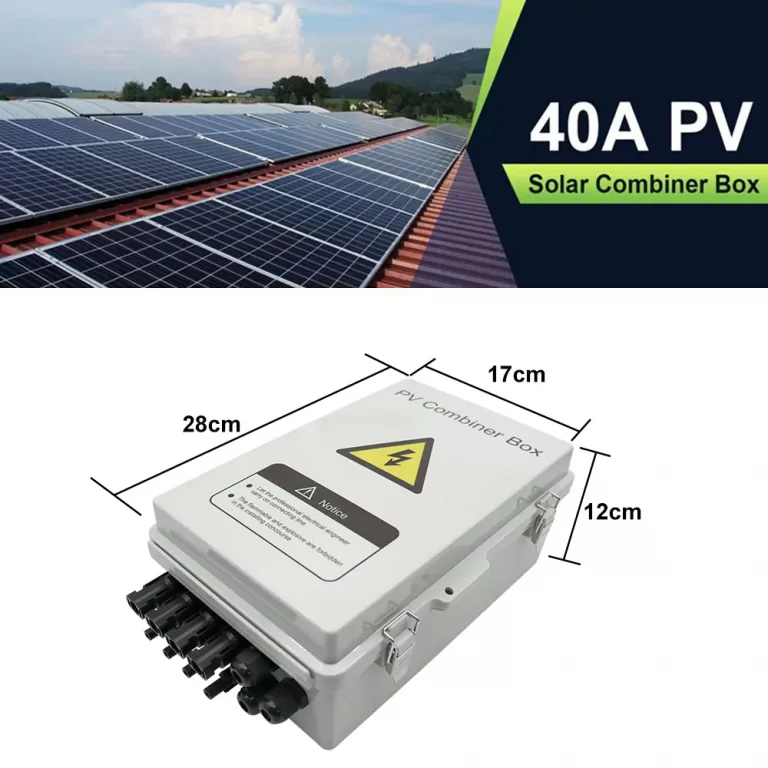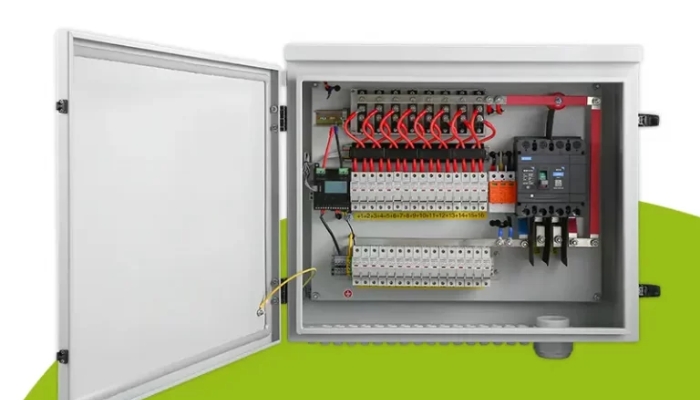In the solar energy sector, the main function of a combiner box is to combine the current output of multiple solar panels while providing protection and fault monitoring functions to ensure the safe and efficient operation of the solar system.
This article will delve into the definition and inner workings of a combiner box and explore how it can improve the performance and safety of solar installations.
Table of Contents
ToggleWhat is a combiner box?

A combiner box is an electrical device used in solar installations to combine the output of multiple solar panels into one circuit, thereby increasing system efficiency and providing safety features such as overcurrent protection.
It is equipped with overcurrent protection devices such as fuses or circuit breakers to protect each solar panel and the entire system from electrical faults.
Advantages of combiner box
The benefits of a combiner box in solar energy systems mainly include:
- Improved efficiency: Combine the output of multiple solar panels to reduce power loss.
- Enhanced safety: Built-in circuit breaker or fuse to prevent overload and short circuits.
- Easy to monitor and maintain: Centralized power lines for easy inspection and maintenance.
- System scalability: Convenient to add additional solar panels.
- Simplified installation: Reduce electrical wiring and reduce installation complexity.
- Clean design: Reduce scattered wires and improve professional appearance.
Disadvantages of combiner box
- Increased cost: Introduce additional equipment and installation costs.
- Energy loss: Small but existent energy loss.
- Space requirements: A certain amount of installation space is required.
- Maintenance requirements: Regular inspection and maintenance are required.
- System complexity: May increase the operational complexity of the system
How does a combiner box work?

The function of a combiner box in a solar photovoltaic system is to aggregate the electrical output of multiple solar panels into a single conduit that is then fed into the system’s inverter.
Inside the combiner box, each solar panel connection is equipped with its fuse or circuit breaker to protect against overcurrent and potential electrical faults.
This setup not only simplifies wiring and reduces installation complexity, but also improves safety by isolating electrical problems to a single solar panel without affecting the entire array.
Type of combiner box
In solar photovoltaic systems, there are many types of combiner boxes, depending on the size, complexity, and specific needs of the system, and many types serve specific functional and configuration requirements. Here are some common types of combiner boxes:
Standard combiner box
This is the most basic type, used to combine the output current of solar panels into one output and directly deliver it to the inverter. Usually includes fuses or circuit breakers configured for each input, and current over-line.
Photovoltaic combiner box
It is mainly used to combine the output current of multiple solar panels and then unify the pipeline to the photovoltaic device.
It usually includes a fuse or grounding protection system, and a cable bridge overcurrent and voltage fluctuations, and can also be equipped with monitoring equipment for real-time detection and recording of line performance, especially for large-scale commercial or industrial solar power plants.
Series combiner box
To organize the design of solar panels in strings, this combiner box handles the output of multiple strings and combines them. It often contains a monitoring system for checking the performance of each string.
DC combiner box
This type of combiner box is used in systems with direct current (DC) output, capable of combining multiple DC sources, and has protection and switching functions.
AC combiner box
In a solar panel integrated PV system, each panel has an alternating current (AC) output. The AC combiner box combines these outputs before sending power to the grid or central PV.
Smart combiner box
Equipped with advanced monitoring and communication capabilities, smart combiner boxes can track performance data for each connected string or panel, detect faults, and often provide remote diagnostic capabilities.
Combiner boxes, depending on their design and function, provide specific advantages and necessary functions for solar PV systems.
How does a combiner box improve the performance of a solar installation?

There are many types of combiner boxes for us to choose from, and each type has different functions. Next, let us explore how these combiner boxes can effectively improve the performance of solar energy installations.
- Power management: Combines the output of multiple panels to improve the efficiency of power transmission.
- System safety: Built-in protection devices such as fuses or circuit breakers prevent overloads and short circuits, protecting the system from stable operation.
- Monitoring and maintenance: Equipped with monitoring functions, it facilitates real-time detection and fault diagnosis, and simplifies maintenance.
- Simplified installation: Reduces the number of cables directly connected to the inverter, reducing installation complexity and cost.
- System scalability: Conveniently add new panels and support system expansion on demand.
In summary, the combiner box greatly improves the overall performance and reliability of solar installations in solar systems by providing effective power management, enhanced safety, convenient monitoring and maintenance, and a simplified installation process.
How to choose the best combiner box?
The role of combiner boxes in solar installations not only helps improve the efficiency of the system but also improves the safety of the system by centrally managing wires. Therefore, these factors should be considered when choosing a good combiner box:
- System capacity: Make sure the combiner box can handle the total current and voltage of all solar panels and is equipped with enough input ports.
- Voltage and current rating: The choice of combiner box should meet or exceed the maximum output of the solar array.
- Protection function: You can choose a combiner box with comprehensive protection functions such as overcurrent protection, surge protection and reverse current protection.
- Monitoring ability: Consider a combiner box with monitoring functions to track the performance of each solar string.
- Durability and quality: Use a combiner box with strong weather resistance and relevant safety certifications (such as UL certification, and IP65 protection level).
- Installation and maintenance necessity: Make sure the combiner box design must be installed and maintained, such as equipped with safe fuse holders, voice tags, etc.
Combining these factors will help you choose the most optimized combiner box to improve the performance and safety of your solar system.
Conclusion
Simply put, the combiner box in a solar system aggregates the power output of multiple solar panels. The combiner box simplifies the complexity of wiring, maximizes the potential energy output, and significantly improves the efficiency and safety of photovoltaic equipment. Through this article, you can understand the definition, advantages, and disadvantages of the combiner box and its role. I believe you can choose the most suitable combiner box for your solar equipment.
MOREDAY offers a series of high-quality combiner boxes with overcurrent and surge protection. They are made of durable, weather-resistant materials and support a variety of customization options to meet different installation needs.
MOREDAY combiner boxes are certified to industry standards to ensure reliable performance under various conditions. Come and contact us for a quote! Whether you are buying retail or wholesale, MOREDAY will answer your questions with the most sincere service attitude!


